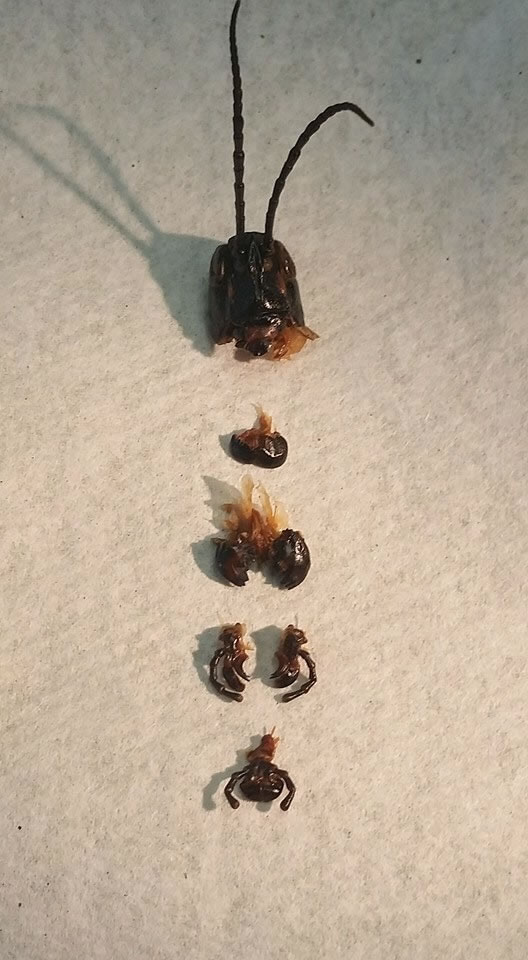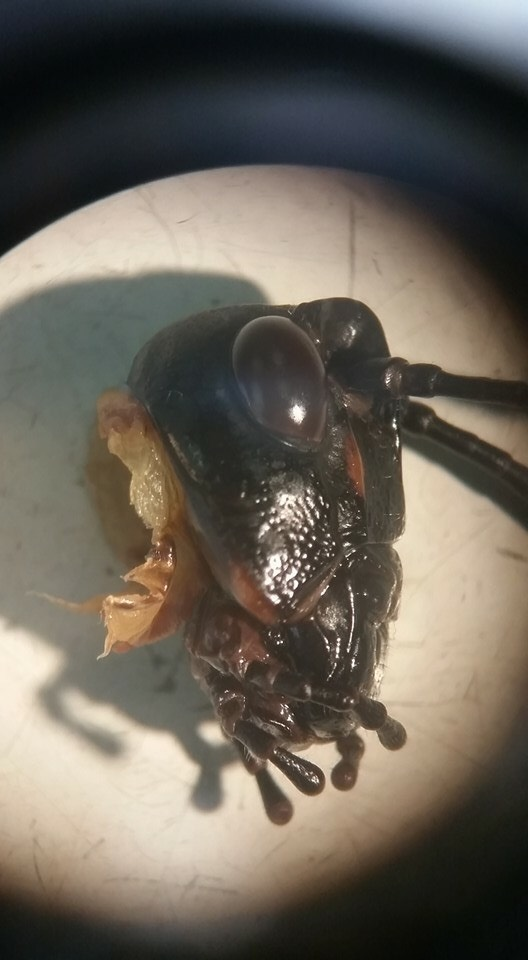Exploring Structure and Function in Insects
By Cindy Workosky
Posted on 2018-10-24
As an entomologist, one of my greatest challenges is trying to overcome my students’ feelings of fear and disgust regarding insects. Insects often have negative images in society. Walk through any toy store, and you will likely find plastic insects with the words “gross” or “creepy” written on their colorful packaging.
One of our main jobs as educators is to give students informative experiences that correct misconceptions and open their minds to new ideas. To accomplish this, I incorporate insects into my lessons.
Insects are excellent models for many behaviors and physical adaptations. Because of their diversity (i.e., millions of species!), insects offer numerous examples of reproductive, defensive, foraging, and feeding strategies. One area of the NGSS in which using insect models works well is with the Crosscutting Concept (CCC) of structure and function. Encouraging students to learn about the structures that evoke so much fear opens doors to further curiosity and learning.
A structure-and-function investigation that students especially enjoy involves insect mouthparts. This two-part investigation is easily adaptable and can be used in many units of instruction, ranging from comparative morphology to adaptations.
Insect mouthparts
How is the structure of the mouthparts a reflection of their function and the insect’s diet type? Insect feeding serves as the phenomenon for this investigation.
Part 1: Behavioral analysis of mouthparts
Give students an assortment of adult insects that have different types of mouthparts: for example, grasshoppers or caterpillars (chewing mouthparts), houseflies (sponging mouthparts), mosquitoes or stink bugs (piercing-sucking mouthparts), butterflies (siphoning mouthparts), bees (chewing-lapping mouthparts), or horseflies (rasping mouthparts). Using magnifying glasses or dissecting microscopes, students observe and describe the mouthparts as they function on a moving, living organism. You will be surprised about how amazed students will be to observe a living insect and its complexity. Allow them to formulate hypotheses regarding which foods each mouthpart type is best suited for consuming. Provide students with leaves and sugar water–soaked sponges for feeding their insects. How accurate were their hypotheses?
Allow students to observe feeding using their magnifying glasses or microscopes. They will be able to see that the mouthparts are interacting appendages that work together to manipulate and consume food. What different mouthpart appendages do they see? How are each of these components shaped? How do they manipulate the food? How does each component’s shape reflect its apparent function?
Part 2: Mouthpart dissection
Yes! Dissections can fit into an NGSS framework. Separating all components of grasshopper mouthparts during a small dissection exercise reinforces the concept of interacting structures and allows students to better visualize the structure of each mouthpart appendage. For this dissection, I recommend using large grasshoppers. Grasshoppers have chewing mouthparts that allow them to eat solid foods, like leaves. Of all the insect mouthpart types, chewing mouthparts have the greatest number of similarities to the human mouth. Preserved specimens can be ordered for a low price from a scientific supply company.
 Divide students into pairs, and provide each pair with a grasshopper. Have students use dissecting scissors and a probe to carefully separate and disconnect the different components of the mouthparts. Have students create an expanded view of the mouthparts by placing them on their dissecting trays, as in the photo.
Divide students into pairs, and provide each pair with a grasshopper. Have students use dissecting scissors and a probe to carefully separate and disconnect the different components of the mouthparts. Have students create an expanded view of the mouthparts by placing them on their dissecting trays, as in the photo.

Use the following questions to guide the investigation:
- Do any of these components resemble structures of the human mouth?
- Some of the mouthpart appendages are composed of many tiny segments and contain microscopic hairs. What other structures on the grasshopper or the other insects from part 1 have a similar structure? What do you think this means in terms of function?
- Describe the shape and composition of each mouthpart appendage. How do you think each component contributes to food manipulation or consumption?
- What other types of insects do you expect to have similar mouthparts?
- How do you think these mouthparts would differ if the insect ate firm, woody plants instead of leaves?
- Consider part 1. Which appendages do you think are modified in these other mouthpart types? Which components, if any, do you think are common across mouthpart types?
- What body systems are involved in mouthpart movement, taste perception, and digestion of the consumed food?
Customize this investigation to fit your needs!
- Add modeling! Have students create models of the process of food consumption. Models can be created before the investigation, then revised as new evidence is gathered in the dissection. These models serve as excellent artifacts of student learning.
- Is your class ready for a full-body dissection? Have students dissect the grasshopper’s body to reveal the structures of the digestive system. This provides for a more comprehensive lesson, covering all structures from consumption to excretion.
- Don’t have access to grasshoppers? No problem! Modify the investigation by having students perform an online or literature search for images of grasshopper mouthpart components. Have students then create paper cutouts of each of the components. Stack the components as they would exist in a living grasshopper, and fasten them together using a metal brad. Allow students to move the pieces around as if the insect were chewing. Have them describe the structure of each piece and consider the interactions in their paper models to deduce the function.
I hope you will be inspired to use insects in your classroom. Working with these organisms is likely a new experience for your students and a great way to illustrate the complexity of life all around them. How have you used insects in your classroom? What other topics could be brought to life in your classroom with an insect model?
Happy dissecting!
This investigation builds upon:
|
Disciplinary Core Ideas |
Crosscutting Concepts |
|
LS1-A: Structure and Function
|
Structure and Function
|
|
Students investigate the interacting structures of insect mouthparts and determine their individual, specialized functions through behavioral analysis and physical observation (dissection). Teachers are given the option to further investigate this DCI by completing the full body dissection in the “Customize this Investigation” section. |
|
 Angela Cruise is president of Cruise Consulting Group, LLC, which specializes in lesson development and educational consulting for the agricultural, forensic, and life sciences. Cruise has a bachelor’s degree in biology from Loyola University Maryland and a PhD in entomology (forensic entomology concentration) from North Carolina State University. She has taught science at the college level and has organized and participated in dozens of elementary and middle school outreach events across North Carolina. Cruise has developed lessons for one of the country’s largest biological suppliers and has participated in several intensive NGSS training programs. She is excited to share her love of insects with students and teachers everywhere!
Angela Cruise is president of Cruise Consulting Group, LLC, which specializes in lesson development and educational consulting for the agricultural, forensic, and life sciences. Cruise has a bachelor’s degree in biology from Loyola University Maryland and a PhD in entomology (forensic entomology concentration) from North Carolina State University. She has taught science at the college level and has organized and participated in dozens of elementary and middle school outreach events across North Carolina. Cruise has developed lessons for one of the country’s largest biological suppliers and has participated in several intensive NGSS training programs. She is excited to share her love of insects with students and teachers everywhere!
Note: This article was featured in the October issue of Next Gen Navigator, a monthly e-newsletter from NSTA delivering information, insights, resources, and professional learning opportunities for science educators by science educators on the Next Generation Science Standards and three-dimensional instruction. Click here to sign up to receive the Navigator every month.
Visit NSTA’s NGSS@NSTA Hub for hundreds of vetted classroom resources, professional learning opportunities, publications, ebooks and more; connect with your teacher colleagues on the NGSS listservs (members can sign up here); and join us for discussions around NGSS at an upcoming conference.
The mission of NSTA is to promote excellence and innovation in science teaching and learning for all.
Future NSTA Conferences
2018 Area Conferences
2019 National Conference
Follow NSTA
Disclaimer: The views expressed in this blog post are those of the author(s) and do not necessarily reflect the official position of the National Science Teaching Association (NSTA).
Biology Crosscutting Concepts Disciplinary Core Ideas Life Science NGSS Science and Engineering Practices Middle School High School


